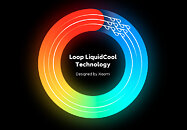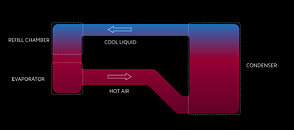Xiaomi today unveiled its latest breakthrough in heat dissipation - Loop LiquidCool Technology. Inspired by cooling solutions used in the aerospace industry, Loop LiquidCool Technology utilizes a capillary effect which draws liquid cooling agent to the heat source, vaporizes, and then disperses the heat efficiently towards a cooler area, until the agent condenses and is captured via a unidirectional closed looped channel. Compared to conventional vapor chambers solutions, this new technology has twice the cooling capabilities and ranks as the most efficient smartphone cooling solution. Xiaomi aims to bring Loop LiquidCool Technology to its products in H2 2022.
This new technology features an annular heat pipe system that is composed of an evaporator, a condenser, a refill chamber, as well as gas and liquid pipes. Placed at heat sources, the evaporator has refrigerant that evaporates to gas when the smartphone is under high workload. The gas and airflow is then diffused to the condenser, where the gas condenses into liquid again. These liquids are absorbed and collected through tiny fibers in the refill chamber—which refills the evaporator—making it a self-sustaining system.



Although this new technology uses the same method as VC liquid cooling, the new form factor makes a significant efficiency difference. As conventional VC systems do not have separate channels for gases and liquids, hot gas and cool liquids mix and obstruct each other while, especially under high workload. The ring-shaped pump features a special gas pipe design, which greatly reduces air passage resistance by 30%. By allowing for a smoother steam flow, the maximum heat transfer capacity is increased by up to 100%.
To ensure one-way high-efficiency circulation, implementing a Tesla valve structure within the refill chamber is crucial. A Tesla valve is a one-way valve that allow liquid to pass through the evaporator, while blocking gases from moving in the incorrect direction. This allows for a higher efficiency in gas/liquid circulation throughout the system.
On a custom Xiaomi MIX 4, the original vapor chamber was replaced with a new Loop LiquidCool Technology solution. During a 30-minute Genshin Impact gameplay test running 60 FPS max video settings, this impressive cooling system kept the device below a max temperature of 47.7℃ and the processor was 8.6℃ lower than the standard version.
Thanks to the one-way circulation, gas-liquid separation, and low heat-resistance gas pipes of the Tesla valve, the flexible form factor also makes it possible to adopt and stack Loop LiquidCool Technology into any type of internal design. For example, a square-shaped loop will allow more space for the battery, camera module, and more.
Introduction Video
View at TechPowerUp Main Site
This new technology features an annular heat pipe system that is composed of an evaporator, a condenser, a refill chamber, as well as gas and liquid pipes. Placed at heat sources, the evaporator has refrigerant that evaporates to gas when the smartphone is under high workload. The gas and airflow is then diffused to the condenser, where the gas condenses into liquid again. These liquids are absorbed and collected through tiny fibers in the refill chamber—which refills the evaporator—making it a self-sustaining system.



Although this new technology uses the same method as VC liquid cooling, the new form factor makes a significant efficiency difference. As conventional VC systems do not have separate channels for gases and liquids, hot gas and cool liquids mix and obstruct each other while, especially under high workload. The ring-shaped pump features a special gas pipe design, which greatly reduces air passage resistance by 30%. By allowing for a smoother steam flow, the maximum heat transfer capacity is increased by up to 100%.
To ensure one-way high-efficiency circulation, implementing a Tesla valve structure within the refill chamber is crucial. A Tesla valve is a one-way valve that allow liquid to pass through the evaporator, while blocking gases from moving in the incorrect direction. This allows for a higher efficiency in gas/liquid circulation throughout the system.
On a custom Xiaomi MIX 4, the original vapor chamber was replaced with a new Loop LiquidCool Technology solution. During a 30-minute Genshin Impact gameplay test running 60 FPS max video settings, this impressive cooling system kept the device below a max temperature of 47.7℃ and the processor was 8.6℃ lower than the standard version.
Thanks to the one-way circulation, gas-liquid separation, and low heat-resistance gas pipes of the Tesla valve, the flexible form factor also makes it possible to adopt and stack Loop LiquidCool Technology into any type of internal design. For example, a square-shaped loop will allow more space for the battery, camera module, and more.
Introduction Video
View at TechPowerUp Main Site




